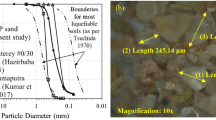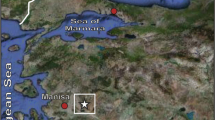Abstract
Carbonate sands that are known as problematic soils, have some unusual features like particle crushability and compressibility that discriminate their behavior from other types of soil. Because of their vast diversity, they have a wide range of mechanical behavior. In recent decades, there have been many attempts to model the mechanical behavior of carbonate sands but all these efforts have been focused on experimental and case studies of some especial sands and there is still no unique way which can appraises all types of carbonate sands behavior and describes their various aspects. In this paper, a new approach is presented based on the integration of Genetic Algorithm (GA) into an Artificial Neural Network (ANN) to predict the shear behavior of carbonate sands. In the proposed approach, the GA was utilized to optimize the connection weights of the ANN. The network was trained and tested using a comprehensive set of triaxial tests that were carried out on three different carbonate sands in both grouted and ungrouted (cemented and uncemented) condition. The network prediction was then compared to the experimental results and it was concluded that the GA-based ANN has a good potential in predicting the behavior and generalizing the training data to simulate new unseen data.


















Similar content being viewed by others
References
Airey DW (1993) Triaxial testing of naturally cemented carbonate soil. J Geotech Geoenviron Eng ASCE 119(9):1379–1398
Allman MA, Poulos HG (1988) Stress-strain behavior of an artificially cemented calcareous soil. In: Proceeding of lst international conference on calcareous sediments. Perth, Australia, pp 51–60
Angemeer J, Carlson E, Klick JH (1973) Techniches and results of offshore pile load testing in calcareous soil. In: Proceeding of the international conference on offshore technology. Houston, Texas, pp 677–699
Balakrishnan SN, Weil RD (1996) Neurocontrol: a literature survey. Math Comput Model 23(1):101–118
Beringen FL, Kolk HJ, Windle D (1982) Cone penetration and laboratory testing in marine calcareous sediments. ASTM STP 777, American Society for Testing and Materials, USA, pp 179–209
Brandes HG (2011) Simple shear behavior of calcareous and quartz sands. Geotech Geol Eng 29(1):113–126
Catano J, Pando MA (2010) Static and dynamic properties of a calcareous sand from southwest Puerto rico. In: Proceeding of the international conference on advances in analysis, modeling and design. ASCE, Florida, pp 842–851
Chipperfield A, Fleming P, Pohlheim H, Fonseca C (2006) Genetic Algorithm for toolbox for use with Matlab. User’s guide, version 1.2. University of Sheffield
Clough GW, Sitar N, Bachus RC, Rad NS (1981) Cemented sands under static loading. J Geotech Eng ASCE 107(6):799–817
Coop MR, Atkinson JH (1993) The mechanics of cemented carbonate sands. Geotechnique 43(1):53–67
Datta M, Gulhati SK, Rao GV (1979) Crushing of calcareous sand during shear. In: Proceeding of the international conference on offshore technology. Houston, Texas, pp 1459–1474
Demuth H, Beale M (2000) Neural network toolbox learning for use with MATLAB. The Math Works Inc., Natick, MA
Demuth H, Beale M, Hagan M (2007) Neural network toolbox 5 user’s guide. The MathWorks Inc., Natick, MA
Dupas JM, Pecker A (1979) Static and dynamic properties of sand-cement. J Geotech Geoenviron Eng ASCE 105(3):4198–4436
Fausett LV (1994) Fundamentals neural networks: architecture, algorithms, and applications. Prentice-Hall Inc., Englewood Cliffs, NJ
Flood I, Kartam N (1994) Neural networks in civil engineering. I: principles and understanding. J Comput Civil Eng 8(2):131–148
Grine K, Glendinning S (2007) Creation of an artificial carbonate sand. Geotech Geol Eng 25(4):441–448
Grine K, Attar A, Aoubed A, Breysse A (2011) Using the design of experiment to model the effect of silica sand and cement on crushing properties of carbonate sand. Mater Struct 44(1):195–203
Hassanlourad M (2008) Thriaxial shear behavior of non-cemented and chemically grouted carbonate sands. Ph.D. Thesis, Iran University of Science and technology, Tehran, Iran
Hassanlourad M, Salehzadeh H, Shahnazari H (2010) Mechanical properties of ungrouted and grouted carbonate sands. Int J Geotech Eng 4:507–516
Hecht-Nielsen R (1990) Neurocomputing. Addison-Wesely Publishing Company, Massachusetts, MA
Holland J (1975) Adaptation in natural and artificial systems. The University of Michigan Press, Ann Arbor
Huang JT, Airey DW (1998) Properties of artificially cemented carbonate sand. J Geotech Geoenviron Eng ASCE 124(6):492–499
Ismail MA, Joer HA, Metritt A, Randolph MF (2002) Cementation of porous material using calcite. Geotechnique 52(5):313–324
Johari A, Javadi AA, Habibagahi G (2011) Modelling the mechanical behaviour of unsaturated soils using a genetic algorithm-based neural network. Comput Geotech 38(1):2–13
Lade PV, Overton DD (1989) Cementation effects in frictional materials. J Geotech Eng ASCE 115(10):1373–1387
Maren A, Harston C, Pap R (1990) Handbook of neural computing applications. Academic Press Inc., San Diego, CA
Nicklow JW (2000) Discrete-time optimal control for water resources engineering and management. Water Int 25(1):89–95
O’Rourke TD, Crespo E (1988) Cemented volcanic soil. J Geotech Eng ASCE 114(10):1126–1147
Saxena SK, Lastrico RM (1978) Static properties of lightly cemented sand. J Geotech Eng ASCE 104:1449–1463
Semple R (1988) State of the art report on engineering properties of carbonate soils. In: Proceeding of the international conference on calcareous sediments. Perth, Australia, pp 807–836
Vasechkina EF, Yarin VD (2001) Evolving polynomial neural network by means of genetic algorithm: some application examples. Volume 09. Marine Hydrophysical Institute of National Academy of Sciences, 2 Kapitanskaya St., Sebastopol, 99011, Ukraine, pp 1–13
Zurada JM (1992) Introduction to artificial neural systems. West Publishing Company, Minnesota, MN
Author information
Authors and Affiliations
Corresponding author
Rights and permissions
About this article
Cite this article
Rashidian, V., Hassanlourad, M. Predicting the Shear Behavior of Cemented and Uncemented Carbonate Sands Using a Genetic Algorithm-Based Artificial Neural Network. Geotech Geol Eng 31, 1231–1248 (2013). https://doi.org/10.1007/s10706-013-9646-2
Received:
Accepted:
Published:
Issue Date:
DOI: https://doi.org/10.1007/s10706-013-9646-2




